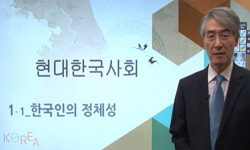王祖說話는 王族의 氏祖說話이다. 王祖說話의 表現形式은 散文體로서 敍述的 表現을 하였고, 漢文으로 記載된 文獻說話에 속한다. 內容은 王祖의 誕生, 治績, 化神의 내용을 神話的으로 ...
http://chineseinput.net/에서 pinyin(병음)방식으로 중국어를 변환할 수 있습니다.
변환된 중국어를 복사하여 사용하시면 됩니다.
- 中文 을 입력하시려면 zhongwen을 입력하시고 space를누르시면됩니다.
- 北京 을 입력하시려면 beijing을 입력하시고 space를 누르시면 됩니다.
https://www.riss.kr/link?id=T732300
- 저자
-
발행사항
광주: 全南大學校, 1987
- 학위논문사항
-
발행연도
1987
-
작성언어
한국어
- 주제어
-
KDC
813.7 판사항(3)
-
DDC
895.73 판사항(19)
-
발행국(도시)
전라남도
-
형태사항
167p; 27cm
- 소장기관
-
0
상세조회 -
0
다운로드
부가정보
국문 초록 (Abstract)
王祖說話는 王族의 氏祖說話이다.
王祖說話의 表現形式은 散文體로서 敍述的 表現을 하였고, 漢文으로 記載된 文獻說話에 속한다.
內容은 王祖의 誕生, 治績, 化神의 내용을 神話的으로 表現함으로써 위대한 國祖觀, 神聖한 氏祖觀, 肇國治世의 當爲性, 名門後裔의 自負心과 矜持感을 갖도록 했다.
韓國의 王祖說話는 氏祖說話의 性格을 띠고 있으면서도 歷史上의 時代的 背景을 明白히 하고 있는 說話이므로 檀君說話는 「檀君朝鮮」, 朱蒙說話는 「高句麗」, 朴赫居世說話·昔脫解·金閼智說話는 「新羅」, 金首露說話는 「駕洛」, 三姓說話는 「耽羅」라는 國家的 背景을 가지고 있다.
王祖의 誕生方法에 의한 類型은 天降型, 卵生型, 聳出型, 漂流型이다.
血統의 連續性을 존중하고, 家門의 傳統을 소중히 생각하는 韓民族은 家門傳來의 說話를 간직함으로써 그 가문의 자손들에게는 名門의 긍지를 갖게 하였을 뿐 아니라, 他氏族에 대한 優位性을 선양하는데 큰 몫을 차지하였다. 이러한 說話의 자료를 발굴하고 정리·연구함은 우리의 博統文學을 찾는 길이며, 이에 관한 새롭고도 깊은 연구는 文學的 견지에서만 중요한 것이 아니라, 韓民族의 思想, 宗敎, 歷史, 社會, 民俗 등의 연구에도 기여하는 바가 크다고 본다.
王祖說話의 종합적 연구의 기초 작업으로서 각 왕조설화를 구성하고 있는 主要話素의 正確한 解釋이 필요하며, 각 설화의 결정적 요소가 되는 motif의 理解가 이루어져야 하고, 각 王祖說話의 話素·內容·類型上의 特性을 究明해야 한다.
각 왕조설화의 특성을 찾아서 이를 상호 비교한다. 씨족설화를 분류하고, 이를 문학적, 사회적, 사상적, 종교적, 민속적 측면에서 고찰함으로써 왕조설화의 종합적 가치의 탐색을 모색한다.
이상과 같은 목적을 달성하기 위해서 연구한 결과 다음과 같은 결론을 내린다.
단군설화는 구성상으로 볼 때에, 단순한 story로 엮어져 있는 것이 아니고, 어떠한 사건이 인과 관계의 질서 속에서 서술되고 있는 plot로 짜여져 있다. 사건의 구성은 한 씨족의 조상이 천상에서 지상으로 내려옴으로써 그 氏族의 始祖는 神聖性과 존엄성을 갖추고 있는 神이었음을 암시하게끔 짜였다. 그럼으로써 시조에 대한 畏敬心과 조상숭배사상의 총체적인 의미를 부여하게 된다.
단군설화를 씨족설화로 다룬 것은 단군의 후손이 오늘날의 어떤 구체적인 姓氏를 가진 후손들로서 현존하지 않지만, 어느 한 씨족의 始祖를 이야기하고 있음이 틀림없다. 그 어느 한 씨족이 韓民族이며, 韓民族의 始祖를 단군으로 생각할 때에는 그에 관한 설화는 한 氏族의 始祖說話이다.
氏祖說話는 祭儀와 生活風習을 그 구조적 기저로 삼고 있다는 보기를 단군설화에서 충분히 찾을 수 있다.
단군설화는 구성상, 내용상, 규모상으로 보아, 韓國氏族說話의 본이 되고, 古代人의 思考, 社會, 文化를 알 수 있는 神話的 氏族說話로 본다.
朱蒙說話는 日照卵生의 motif가 시조탄생의 주요인으로 되어, 日子卵生說話임을 확실히 밝히고 있다. 주몽설화는 母性意識이 부각되었고, 활 잘 쏘는 motif는 활동적이고, 武勇的인 고구려 민족을 상징적으로 표현하고있다.
朴赫居世說話는 물에 빌어서(祈水) 아들을 얻는(得子) motif가 주인공 탄생의 主要因이 되었고, 이는 즉 '源水' 관념과 '□浴' 祭儀에 연유된다. 혁거세의 죽음은 탄생과 부활을 상징하는 죽음이며, 再生의 主題를 표현한 것이며, 또한 夫婦意識觀念이 잘 나타나 있다.
金首露說話는 전개 방법이 박혁거세 설화와 유사점이 많고, 金首露의 神異的인 탄생과 許皇后의 전설적 설화가, 혼융되어 구성된 두 씨족의 시조설화이다.
高·梁·夫의 三姓 설화는 4단계로 구성되었고, 地生說을 바탕으로 하는 설화이다.
昔說解說話는 海路를 거쳐 이주해 온 冶匠族이 세력을 잡고 朴氏族의 王에 이어 易姓 繼位한 사실을 說話한 것이다. 그리고 화소의 다양성과 사건의 계기적 구성은 다른 씨족설화에서 보인 것보다 비교적 극적이고, 寫實的이어서 단순한 story에 그치는 것이 아니고, 평면적이고 서술적이기는 하지만 plot의 꾸밈새가 우수하다.
김알지설화는 박혁거세설화와 유사한 점이 많고, 알이 표면적으로 나타나지 않았지만 닭이 울었다 함은 새벽의 햇빛과 알을 암시한다.
王祖說話에 관한 연구 결과를 要約하면 다음과 같다.
1) 王祖說話는 古代國家의 王祖가 出生, 建國, 治國, 得姓嗣位한 사건을 說諸化한 王祖의 氏視說話이다.
2) 王祖說話가 國家 및 氏族意識에 의하여 類別된다면, 建國王祖說話, 建國得姓王祖說話, 得姓王視說話로 구분된다.
3) 韓國의 王祖說諸는 神話學的 입장에서 論議되기 때문에 神話的 내용 및 性格을 띤, 이른바 神話時代의 說話로 간주된다.
4) 王祖說話의 核心的 要素는 空間素로서의 하늘과 땅, 天氣素의 빛·구름·소리·줄(繩), 夫婦意識을 강조한 王妃, 王祖誕生의 背景素인 산·숲·굴·바위·샘·강, 바다와 여러 종류의 동물(곰·호랑이·말·거북·용·소·말·돼지·까치)과 出生 motif의 天降, 卵生, 聳出, 漂流와 陰陽素로서의 天·地, 聖·俗, 明·暗, 男·女, 岩·井, 山·海 등이다.
5) 王祖說話의 主要 motif는 天降, 卵生, 聳出, 漂流, 獸祖, 祈子, 禁忌, 遺棄, 假化, 化身, 日照卵生 等인데 天降, 卵生, 聳出, 漂流 등의 motif는 韓國王祖說諸의 類型上 特性을 결정짓는데 직접적인 요소가 된다.
6) 韓國의 王祖說話는 傳承·表記上의 특색이 있다. 說話는 口碑傳承의 형식을 취해야만 되는데, 韓國의 王祖說話는 漢文으로 記載된 文獻說話이다.
7) 構成上의 特質은 平面的 구성법을 쓰면서 傳奇文學의 형태를 취했고, 表現上의 特質은 敍述的 表現方法에 있다.
8) 韓國王視說話의 構造上의 思想的 基底는 天神崇拜이다.
9) 王祖說話는 □浴祭儀, 祈子祭儀, 通過祭儀를 그 구조적 基底로 하고 있다.
10) 韓國의 王祖說話를 내용상으로 볼 때에, 多樣한 神話的 話素의 구성에 의한 상징적 표현으로써 古代社會人의 天神崇拜·崇祖愛宗思想이 강조되고, 後孫들로 하여금 天孫이라는 自負心과 矜持感을 鼓吹시켰고, 氏族說話로서의 문학적 가치는 물론, 歷史的, 哲學的, 社會學的으로 그 가치가 인정되는 說話로 본다.
韓國의 王祖說語 硏究에 期待되는 成果는,
첫째, 치밀하고 정확한 화소의 분석과 해석으로 王祖說話의 올바른 理解를 圖謀할 수 있고,
둘째, 韓國의 氏族說話 硏究에 分析的 方法의 基盤을 構築했고,
세째, 外國의 氏族說話 및 王祖說話와의 比較硏究에 도움이 될 것으로 思料된다.
다국어 초록 (Multilingual Abstract)
The narratives of Korean dynastic fathers mean the narratives about fathers of royal families. These narratives are prosaic in expression. They are also recorded in Chinese characters. Their contents include the birth, familyname acquition, administra...
The narratives of Korean dynastic fathers mean the narratives about fathers of royal families. These narratives are prosaic in expression. They are also recorded in Chinese characters. Their contents include the birth, familyname acquition, administrative achievements, and deification of the fathers.
As these narratives are written mythically, the races, tribes and clans who preserved them realize a view of great father, a view of divine clan father, and the justification of national foundation and reign, and keep in mind self-confidence and pride as a scion.
The narratives of Korean dynastic fathers are characteristic of narratives about clan fathers and also they have national time background. On that ground, Tan-gun narratives reflect the time of Tangun-chosen, Chumong narrative the time of Koguryoˇ, Park-hyoˇkgoˇse, Soˇk-thalhae, and Kim-aljee narratives the time of Silla, Kim-suro narrative the time ef Karak, and three-family name narrative the time of Thamra.
To classify them according to their birth ways, there are Choˇngang type, Nan-saeng type, Yong-chul type, and Phyo-ryu type in the narratives of Korean dynastic fathers.
For Korean people who think much of continuity of the blood and the tradition of their families, the transmission of these narratives made their descendants not only take great pride in a scion but also play important roles in promoting their superiority over other families. Therefore, to dig out possible materials for these narratives and to arrange and study them systematically are a good way to find out our cultural heritage, and a new and profound study on this subject is immense and important not only in aspect of literature, but in the studies of Korean thought, religion, history, community, and folkwys.
To make the contents clear under the necessity of their study, first, it is necessary to collect extensive data on clan narratives. Second, the collected materials must be arranged and analized for this study. Finally it is necessary to examine through this study of clan narratives how Korean consciousness of race, blood relation, solidarity, the high and the low, traditional institution of feudal lineage, and the idea of ancestor worship are projected to clan narratives.
The purpose of this study is to dig out clan narratives as many as possible, to arrange them systematically and to give right literary interpretation and appreciation, to examine contents which people intended to express in these narratives and to compare them one another after finding out characteristics of each narrative, and to attempt to find out synthetic values of clan narratives after classifying them in typology and investigating them in the aspects of literature, myth, thought, religion, and folk. Finally this study is to dianose students' interest in clan narratives.
The results of this study for the above purpose are as follows:
Tan-gun narrative is not made of a simple story in plot, but it has a plot that an event is described in the order of causally. The plot of the event that the ancestor of a clan came down from heaven, was formed to suggest that he is a holy and majestical god. Thus the awe of the ancestor and the idea of ancestor worship are well brought out in clan narratives. The treatment of Tan-gun narrative as a clan narrative, though it is doubtful today which clan among today's many clans is true Tan-gun's blood, suggests that Tan-gun must be an ancestor of a today's clan. From this point, it is said that the narrative of Tan-gun is that of a clan ancestor, and broadly it belongs to clan narrative.
In this Tan-gun narrative we can see an example that a rite and a way of life form the foundation of myth. This narrative is considered as a typical model of Korean clan narratives in plot, content, and scope, and as a mythical clan narrative which suggests the idea, community, and culture of ancient people.
In Chu-mong narrative the pregnancy by taking sunlight as motive is the main cause of Chu-mong's birth, and such a fact proves clearly that this narrative means the narrative that an egg is turned into a baby as the sun shines over it. The maternal consciousness appears in this narrative. The motive that Chu-mong is a good archer represents symbolically that people of Koguryoˇ are active and brave.
In Park-hyoˇkgoˇse narrative the main cause of his birth is the motive to get a child by praying to the water. In other words, this comes from ideas of "urwasser" and "toilet rite" The king's death symbolizes "birth and regeneration", and it also represents the theme of "revival". The conjugality is embodied in this narrative and Kim-suro narrative.
Kim-suro narrative is analogous to Park-hyoˇkgoˇse narrative in the process of development. This is the narrative of two clan fathers, that is, Kim's miraculous birth and a legendary narrative of the empress, Hoˇ.
In Soˇk-thalhae narrative the blacksmith who immigrates by see gather strength and succeeds to the throne after Park's reign, a clan. Thus this narrative shows the idea of succession by other clans. The variety of motive and the occational plot, of event are more dramatic and more realistic than those in other narratives. So this narrative is not limited to a simple story, but a good work in plot, though plain and descriptive.
The narrative of three family names, Ko, Yang, and Pu, consists of four structural phases, and it is based on Chi-saeng theory that they were born from earth.
Kim-aljee narrative bears a close parellel to that of Tan-gun. In these narratives, though it is not brought out on the surface, the idea that cocks crow indicates the egg and the first light of the day.
In short, the results of this study on narratives of Korean dynastic fathers as follows:
1. The narratives of Korean dynastic fathers are the clan father narratives of such events as how fathers were born, how they set up their nations, how they ruled over their nations, how they got their families, and how they succeeded to the throne.
2. To classify these narratives by the consciousness of clan and nation, there are narratives of fathers founding a nation, narratives of fathers founding and getting a family name, and narratives of fathers getting a family name.
3. Because the narratives of Korean dynastic fathers are examined from the viewpoint of mythology, they are considered as narratives of mythical times, tinged with mythical contents and characters.
4. The primary motives of these narratives are as follows: Space motives are heaven and earth, celestial motives light, clouds, sound, and line, backing motives of birth mountain, woods, cave, rock, spring, river, sea, and various kinds of animals, cosmic dual force motives heaven and earth, sacredness and vulgarity, lightness and darkness, man and woman, rock and fountain, and mountain ana sea, and birth motives Choˇn-gang, Nan-saeng, Yong-chul, and Phyo-ryu.
5. The primary motives of these narratives are Choˇn-gang, Nan-saeng, Yong-chul, Phyo-ryu, animal ancestor, taboo, abandonment, transformation, deification, and birth from eggs during sunlight. Here the first four of above motives are the direct factors which mark the characteristics of Korean dynastic father narratives.
6. These narratives show some features in transmission and description. The narratives must be transmitted orally. But the narratives of Korean dynastic fathers are recorded in Chinese characters.
7. These narratives are objective in plot, of romance in type, and decriptive in expression.
8. These narratives are founded on the idea of god worship.
9. The narratives of Korean dynastic fathers have toilet rite, a rite of praying a child, and a rite of passage as structural basis.
10. These narratives include various mythical motives in contents, and they are symbolic in expression. They also emphasize the ideas to worship the god and to love descendants, so the descendants who preserved them come to have a pride that they are the descendants of the god. Thus these narratives have various values in history, philosophy, and socialogy as well as in literature.
From this study, we expect, first, to understand the narratives of Korean dynastic father more clearly through careful and exact analysis and interpretation of motives, second, to build up the foundation of analytic methods on the study of Korean clan narratives, and finally, to be helpful to the comparative study with foreign clan narrative.
목차 (Table of Contents)
- I. 序論 = 7
- 1. 王祖說話의 槪念과 範圍 = 7
- 2. 問題의 提起 = 10
- 3. 硏究의 方法 = 11
- II. 建國王祖說話 = 14
- I. 序論 = 7
- 1. 王祖說話의 槪念과 範圍 = 7
- 2. 問題의 提起 = 10
- 3. 硏究의 方法 = 11
- II. 建國王祖說話 = 14
- 1. 檀君說話 = 14
- (1) 天上神意
- (2) 桓雄降世
- (3) 敎化人世
- (4) 熊得女身
- (5) 檀君誕生
- (6) 壽後山神
- 2. 朱蒙說話 = 53
- (1) 解慕漱降世
- (2) 金蛙誕生
- (3) 朱蒙誕生
- III. 建國得姓王祖說話 = 66
- 1. 朴赫居世說話 = 66
- (1) 岸上議論
- (2) 朴赫居世誕生
- (3) 閼英誕生
- (4) 得姓·成婚·建國
- (5) 朴赫居世昇天
- 2. 金首露說話 = 94
- (1) 殊常聲氣
- (2) 降卵異誕
- (3) 立國治行
- (4) 爲妃黃玉
- (5) 首露昇遐
- 3. 三姓(高·梁·夫)說話 = 106
- (1) 三神聳出
- (2) 皮衣肉食
- (3) 靑衣三處女
- (4) 射矢卜地
- IV. 得姓王祖說話 = 118
- 1. 昔脫解說話 = 118
- (1) 阿珍浦異讀
- (2) 龍城國事緣
- (3) 吐含山行蹟
- (4) 脫解王登祚
- 2. 金閼智說話 = 128
- (1) 金閼智誕生
- (2) 得姓·得名
- V. 王祖說話의 特性 = 136
- 1. 諸素上 特性 = 136
- (1) 建國王祖說話의 特性
- (2) 建國得姓王祖說話의 特性
- (3) 得姓王祖說話의 特性
- 2. 內容上 特性 = 141
- (1) 建國王祖說話의 特性
- (2) 建國得姓王祖說話의 特性
- (3) 得姓王祖說話의 特性
- 3. 誕生類型上 特性 = 146
- (1)天降型
- (2) 聳出型
- (3)漂流型
- (4)卵生型
- VI. 結論 = 153
- 參考文獻 = 159
- 英文抄錄 = 163












